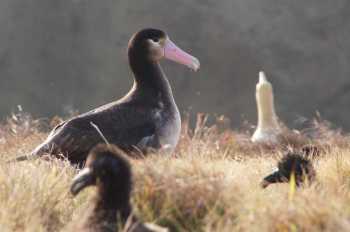The site where Short-tailed Albatross Phoebastria albatrus chicks have been translocated to Japan's Mukojima Island over the last five years is kept under watch by a satellite-linked remote camera operated by NHK, a Japanese broadcasting company. The camera is positioned in the body of a dummy albatross (click here for video).
On 14 November the camera recorded mating between a translocated male bird (Red Y01 - from the first cohort translocated as chicks in 2008 from the breeding colony on Torishima) and a parent-reared unbanded female. Red Y01 had been regularly recorded displaying and engaging in courtship behaviour on site with a naturally-reared bird during the period December 2011 to February 2012 (click here).
Another photo* shows the male standing and calling over a nest containing an egg with the female standing next to it. Characteristic reddish blood stains on the egg's obtuse end confirm it is not a dummy egg that had been placed in the colony to encourage laying. Time will tell whether the egg will be successfully incubated and hatch.

Red Y01 visits Mukojima on a previous occasion
Photograph courtesy of Tomohiro Deguchi
To read more about the history of this incipient colony search on Mukojima on this web site and click here and here for Japanese-language news items and to watch a three-minute video clip on the first Short-tail egg laid on Mukojima.
Meanwhile farther to the East in the USA's North Western Hawaiian Islands on Kure Atoll the partner in intermediate phase plumage of the female-female pair of Short-tails is back on the island incubating two eggs for the third year in a row (click here). This pair has tried to incubate a clutch of two eggs over at least the last two seasons but without a male the eggs have been infertile (click here).
Three Short-tailed Albatrosses have turned up on Midway Atoll recently, including the male of the pair that has bred successfully over the last two years on Eastern Island. News of its partner is still awaited.
With thanks to Tomohiro Deguchi and Kiyoaki Ozaki (Yamashina Institute of Ornithology), Pete Leary (Midway National Wildlife Refuge), Shiro Kagawa (NHK), Cynthia Vanderlip (Kure Atoll Seabird Sanctuary), Friends of the Midway Atoll National Wildlife Refuge and the Kure Atoll Conservancy for information.
John Cooper, ACAP Information Officer, 7 December 2012, corrected 8 December 2012
*This picture has been posted to the ACAP Facebook Page and will be added here once a web site loading problem is solved.

 English
English  Français
Français  Español
Español